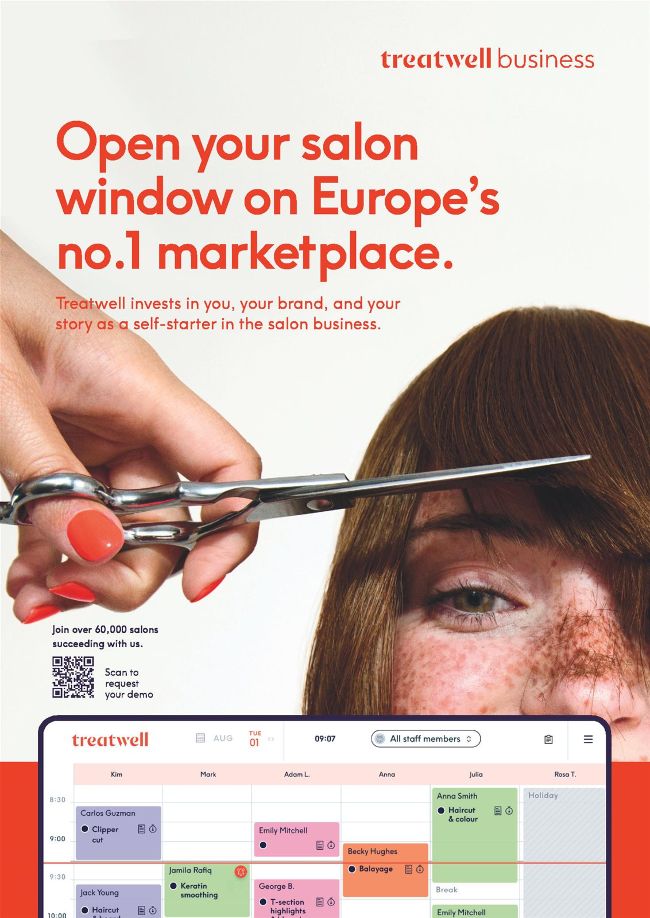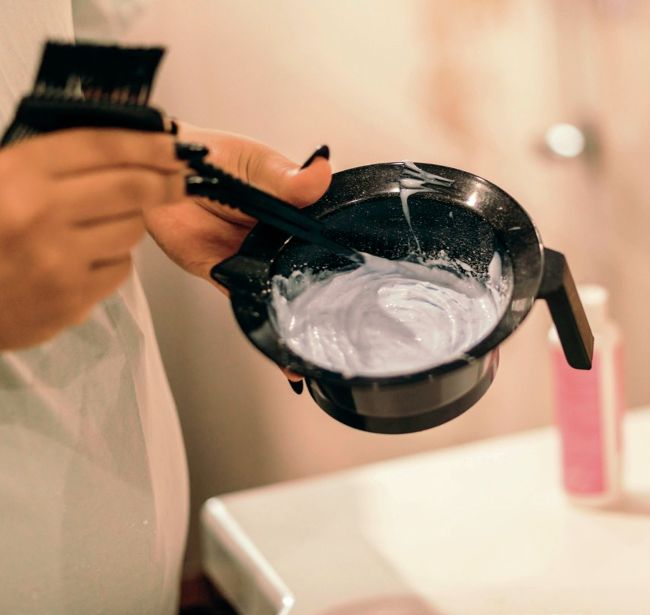CONSULTING ROOM
Colour consultations are an opportunity to discover exactly what your client wants to achieve, so it is crucial to ask the right questions
When it comes to hair colour, there are many components to consider, with the client consultation being one of the most important parts of the appointment. Get this right and you can more or less guarantee the perfect end result, but fail to ask the right questions or, worse still, not listen to the answers, and you could have a problem on your hands.
“A consultation is an integral part of the colour journey,” explains Suzanne Alphonse, Wella Professionals commercial technical education manager UK&I. “Discussing every element in advance means that there are no surprises, and ensures a truly bespoke colour service.”
“Remember, a consultation is a verbal contract between you and a client – it doesn’t have to take all day, but there are many factors to consider,” says Debbie O’Keeffe Crinnion, Osmo lead educator, and owner of Montana Blu Hairdressing and Academy in Fermoy, Co Cork. “Understanding your clienst’s hair history is absolutely crucial to getting the right results, not least from a health and safety perspective. For example, if I’m lightening hair that is long, I need to be aware of any previous services. I also want to consider my client’s skin tone and eye colour, and make sure the hair shade that we agree on is going to complement these.”
When it comes to creative colour, the importance of a detailed and thorough consultation is further amplified, notes Siobhan Jones, L’Oréal Professionnel global ambassador. “A creative colour is anything outside your normal realm of colouring. This could include being creative with mixing formulas, using unique colour combinations and mixtures, or placing your colour in a more thought-provoking way. The great thing about offering a creative colour is that it will be totally unique to you. The creativity comes from you, so the client would need to return to you and your expertise to recreate it.”
“By actively listening to the client during a thorough consultation, we can tailor techniques to achieve the perfect end result,” says Amy O’Sullivan, Schwarzkopf Professional educator and owner of Hair by AOS in Drogheda, Co Louth “Failing to carry out a comprehensive consultation can lead to misunderstandings and dissatisfaction, which could be detrimental to both the client’s hair health and the salon’s reputation. Prioritising the consultation ensures that both the stylist and client are on the same page – so, communicate, assess and then create!”
Manage expectations
There are times when the consultation ends up being led by the client, and that’s when unrealistic expectations can arise. Taking a sensitive, but authoritative approach enables you to gauge what the client wants, and make sure they understand what can be achieved.
“It’s important to remember that not every client can express their ideas, and they may not know what can and cannot be done as they are not technically trained,” says O’Keeffe Crinnion. “Listen to keywords and observe body language to try and choose the right service for them. We have two ears and one mouth for a reason. I like to start off by asking them what they do not want. We can talk forever about things we might like, but we all know what we don’t like. After listening to your client, take control of the consultation, and advise on the reality of what has been discussed. Clients respect an honest consultation; it helps to build up trust in your relationship.”

“I find that being upfront and honest is the best approach,” agrees Coia Styles, hairstylist and educator, and Alfaparf Milano Professional brand ambassador. “I listen to my clients’ needs and wants, however, I manage those expectations and explain clearly what is possible, and what may not be and why. When I was training, I was taught to always ask open-ended questions, and not ones that can be answered with just a ‘yes’ or a ‘no’. It is often beneficial to ask clients what they don’t like about their hair, as this question leads them to being a lot more vocal about what they want to achieve.”
‘Remember, a consultation is a verbal contract between you and a client – it doesn’t have to take all day, but there are many factors to consider’
“It’s important to give a professional opinion, without being dismissive of the client,” notes O’Sullivan. “Instead of saying that a particular look will never work, try engaging in a more open and collaborative dialogue by explaining that while the look is not 100% achievable today, it is something that you and the client can plan to work towards This approach allows us to guide the client towards achievable results, while still honouring their desires.”
Introduce inspiration
If a client brings in a celebrity photograph to show you the look they want, that’s a perfect starting point for discussions. If they don’t, seize the initiative by grabbing a magazine so you can both look for pictures to make sure that you share the same vision.
“Personally, I love it when clients bring a photo as it serves as an excellent conversation-starter, and can provide a visual insight into their preferences,” says O’Sullivan. “Pictures of shades such as warm blondes/ cool blondes, subtle coppers and vivid reds can help clients and stylists have a mutual understanding of what the goal is. Visual aids can also encourage clients to try something new that you might have been nervous to suggest to them.”
“We all have phones now, so even if my client doesn’t show me pictures on their phone, I take out mine to show them some inspiration,” says Styles. “I often show them pictures of what we need to avoid as well. Images are a great way to get us both on the same page.”
“Using celebrity photos can be a great tool, but we have to remember these photos are just a guide, and the client’s hair type and face shape may be completely different to the person in the picture,” says O’Keeffe Crinnion. “That said, celebrity photos are a really good way to make sure that you and your client are on the same wavelength, and they also help keep you up to date with latest trends.”
Ask about lifestyle
Asking your client about their lifestyle will reveal important information about what might affect their hair colour. For example, if they love to swim, you might need to tailor their colour choices. At the very least, you will know to recommend a shampoo and conditioner that will help protect the hair from colour fade and chemical damage, while also boosting your retail sales.
“When choosing hair colour options for a client, it is very important to factor in their lifestyle,” says O’Keeffe Crinnion. “Certain activities require the client to wash their hair more frequently. This will make the hair feel drier over time and the colour will fade faster. Clients who swim or use the gym quite often will need regular shampooing and protection from chlorine, so you need to guide them with the correct colour choice and maintenance regime to help prolong the colour. Recommend the appropriate homecare products and advise them to visit the salon more frequently.”
“Homecare is something we should discuss with every client,” stresses Styles. “I usually raise this at the start of the appointment. A good homecare plan would include anything from three to five products, so I explain to clients which one is most important to purchase next in order to build up their homecare routine.”
“Tailoring the client’s colour choices to fit their lifestyle ensures long-lasting results,” adds O’Sullivan. “Additionally, recommending homecare products such as shampoos, conditioners and masques specifically designed to protect against colour fade and damage demonstrates the comprehensive care you are giving your client beyond the salon.”
Of course, the client’s budget also needs to be taken into account. “When it comes to costs of services, always be honest and transparent about the price, and never assume anything about a client’s budget,” says Teresa Weller for Revlon Professional. “Not only does the cost reflect the service, it also reflects our time, technique and knowledge. Some of our clients may come just twice a year, but they return due to their experience and our professional services.”
‘It is often beneficial to ask clients what they don’t like about their hair, as this question leads them to being a lot more vocal about what they want to achieve’
“The colour service needs to be achievable, but it also needs to be affordable for the client,” says says O’Keeffe Crinnion. “You need to make sure it suits their budget, and that the maintenance does not putting a financial strain on them.”
Avoid a ‘same again’ approach
Asking a client if they want the ‘same again’ is a sign of a lazy stylist who is in a rush. If you’ve reached this place with a client, it may imply you have run out of ideas. “I detest those words,” says Styles. “By using them, we fail to give the client even an option of something different. We all have clients who do want the same thing each time they come to the salon, but you can ask them questions about how they managed the colour at home and if they noticed anything about the tone between appointments. We must always give our client options.”

“Change a client before they change you,” advises O’Keeffe Crinnion. “It’s great when we build a relationship with our clients, and we get to know what they like and what they’re happy with, but don’t always assume that they wouldn’t like to try anything different. Ask them how they felt about their hair after their last appointment, and if there is anything you could have done differently for them. You don’t want to lose a client because you became too complacent and didn’t consider that they would like to try something new.
“A change doesn’t have to be something drastic – in fact, it could be something quite simple. If you do decide to do something different, make sure you’re doing it for the client’s benefit, and not because it’s a look you have seen trending and you want to try it out on someone. That’s what models and classes are for.”
“The consultation is an opportunity to re-evaluate the client’s hair needs and explore any new possibilities,” says O’Sullivan. “By engaging in a thorough and thoughtful consultation, you can suggest updates or changes that keep the client’s look current and tailored to their evolving style preferences.
“If their colour is working, then great, but instead of opting for the ‘same again’ approach, ask them if there is anything they would like to change or try. An ongoing dialogue keeps the client engaged and excited about their hair, and loyal to you as their stylist.”